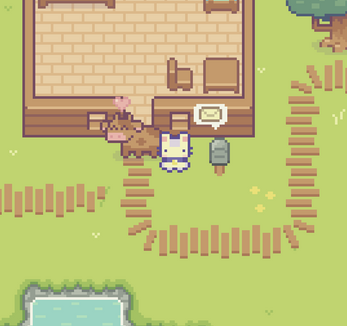First Game!
This is my very first completed game! This is a simple, fetch-quest game with no end. You harvest crops and collect fruits to fulfil the tasks that a mailbox gives you :)
Controls: WASD or Arrow keys to move. Space to interact. Tab to open the task bar. Esc to pause
***update: the 'quit' button doesn't work on web format**
Background info:
I barely have coding knowledge (since I'm a music major), but I really wanted to learn. I decided to make a game using Godot 4. I tried to challenge myself to make this in 2 weeks, but I ended up finishing in about 17 days. Learning everything from scratch was a little difficult Godot 4 is a complete overhaul from previous versions, so most of the tutorials I could find were either outdated or way too few for what I needed.
Despite it all, I think I still managed to create something I am super proud of!! Here are some of the features that I successfully learned and implemented:
- Character movement and toggling between the actions
- Crop and tree animations
- Tilemap layering and collisions (I had multiple layers)
- Walking under bridges (why I created multiple layers lol)
- Counter for resources collected
- Having a task system that would generate random tasks (a pain in the butt)
- COWS WITH RANDOM ANIMATIONS <3
- Radial menus that change locations depending on the object
- Toggling the seed inventory button (animating with Tweens!)
- Instantiating any crop you want to plant
- Main menu and Tutorial "levels" (nearly broke everything)
- Pausing the game
- Dialogue with the dialogue manager plug-in
- Workstation that can take one crop and turn into multiple seeds
I normally make my own assets, but since my goal was to learn to code, I used the lovely Sprout Lands- Asset Pack by Cup Nooble (https://cupnooble.itch.io/) Go support them!! The assets are AMAZING.
I will also be adding audio later lol!
| Status | Prototype |
| Platforms | HTML5 |
| Author | Juliette Limqueco |
| Made with | Godot |

Comments
Log in with itch.io to leave a comment.
i was scrolling through most recent web games, and saw this! really really impressive first project in godot for 17 days!
i do have an ulterior motive for commenting though...i've been having difficulties finding godot 4 resources for the same reasons you listed lol. have any recommendations?
Hello! Thank you for your lovely comments! I won't gatekeep so be prepared for a TON of links:
Starting with the videos I used (not everything, but the main ones that worked for me):
Now for the little tips I learned as a complete beginner (not the most efficient, but I'm learning lol) I'm not sure what your level in coding is, but I will just write these for anyone. These are not in order of when I learned them:
If you made it to the end of this, I wish you good luck on making your game!! Obviously, if you ever have any more questions and comments, I would be happy to answer and learn.
this is amaaaazing! i wasn't really expecting a lot, and this is absolutely fantastic. read the whole thing and am definitely going to be returning to read it more as i keep learning - literally cannot thank you enough
congrats again on this project from its state machine cows to wrangling the bridges! it feels great, and i wish you the best of luck on future projects - i'll keep an eye out!